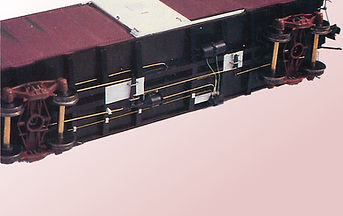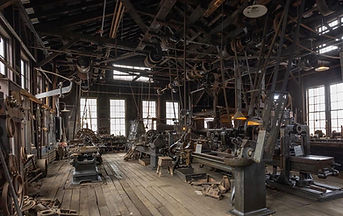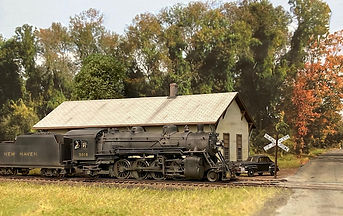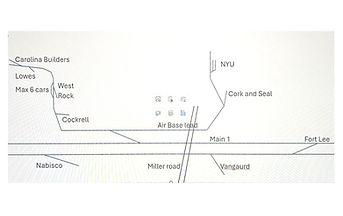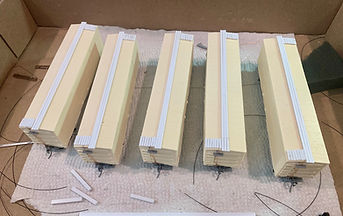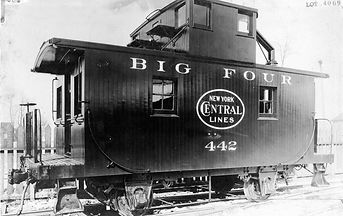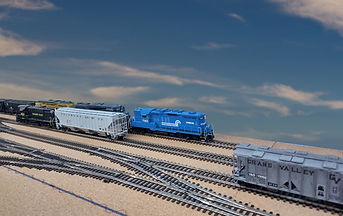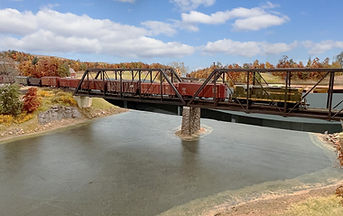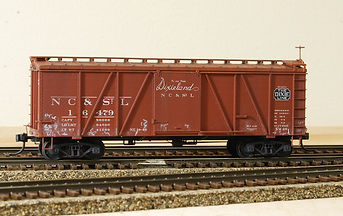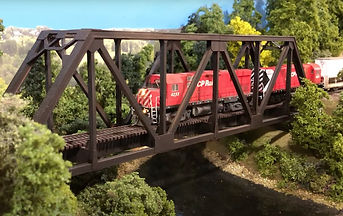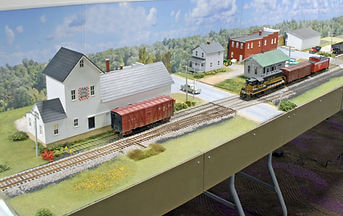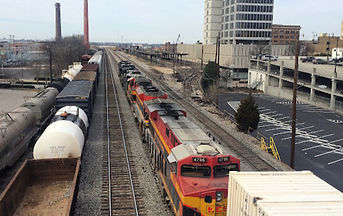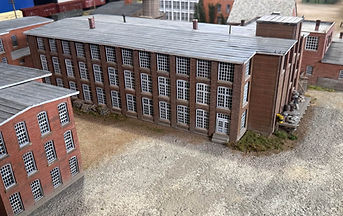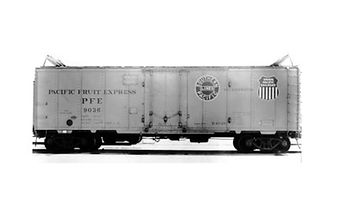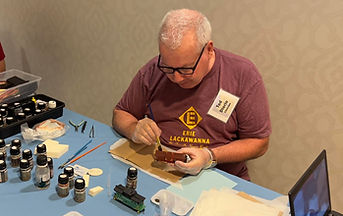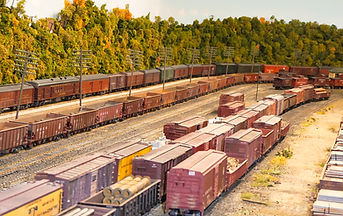CLINICS
The clinics to be presented at MARPM25—subject to change!
Adam McDowell
Army Hospital Cars
Adam is proprietor of Atom Rail, LLC, a one-call full service railroad contractor providing historic railcar repairs, track repairs, and even railway operations. In this clinic Adam will cover the history of moving wounded soldiers on the rails and restoration and alternate use of existing hospital cars.
Andrew Dodge MMR
Scratch Building: One Modeler’s Approach
The clinic will focus on Andrew’s prototype model railroading projects. With more than 70 years in the hobby, it is important to reflect on one’s attitude toward precise, difficult, and complicated projects and how to bring them to fruition. The program will focus on resources, tools, materials, techniques, and lessons learned. For those attending, it will be important to bring along an iPhone or other method of taking notes that he has found useful in his modeling efforts. One of the central parts of the clinic will be a discussion of the methods and materials used in fabricating rolling stock, locomotives, and structures out of wood, brass, and Plexiglas.
Benjamin Hom
Down the Rabbit Hole #2 (Boxcars) – Projects
Since the earliest days of the hobby, manufacturers have offered rolling stock models decorated for prototypes that often had no resemblance to the model. Following up from last year's clinic, we’ll take a closer look at modeling some of the prototypes discussed.
Bernie Kempinski
Rise of the Machines
By the late 19th century, America's Industrial Revolution had a full head of steam. Steam powered machines made the United States the world leader in rail transportation and industrial production. This clinic will describe how steam power was harnessed to make the machines that make other machines. It will show the background, design, and construction of an O scale model steam powered machine shop in an engine house with prototype and model photos. Tips on how to construct a machine shop for any layout including later eras when electrical power replace steam will be presented.
Bill Frankenfeld
Intro to Modular Concepts and Layout Construction
Bill will present the pros and cons of modular model railroading along with resources and techniques. This clinic will be primarily focused on design and construction of the essential layout frame work and how a comprehensive design strategy saves time money and effort. It will cover various types of layout forms and alternatives to major layout building.
Bill Schneider
The Old Woman in the New Basement
Bill Schneider discusses researching and building his personal 18’x30’ double deck prototype-based layout based on the New York, Ontario & Western in upstate New York state circa 1947. The discussion will include where he finds prototype information and how he tries to capture the essence of a scene. He will also discuss designing and making your own laser-cut structures with a hobby-level laser cutter, making your own photo backdrops and more.
Bill Schneider
How We Make Little Choo Choos at Rapido
Bill Schneider, senior product designer at Rapido Trains, walks us through the process of researching, designing and manufacturing models for today's market, with some unique Rapido twists! Includes discussion of choosing what to make, the design process, and working with the Chinese factories.
C. Lawrence “Larry” Goolsby
ACL-SAL-SCL Pulpwood Operations and Equipment in the Southeast
A photo history of the pulpwood business, rail operations, loading, unloading and cars in the southeast on the Atlantic Coast Line, Seaboard Air Line and Seaboard Coast Line. Bulkhead flats for pulpwood, converted wood chip hoppers and built new woodchip hoppers/gondolas and long log cars galore. Paper mills were “big business” in this region, so much so that in 1984 Seaboard System still had a “forester” in the Marketing department.
Chris Adams
Modeling the Valley Local
This presentation covers choosing a prototype to model and my approach to recreating the New Haven Railroad's Connecticut Valley Line, including prototype inspiration, choosing an era, research resources, and available models. The second half of the presentation will show how I've put all this information together to create a time machine to Southern New England in the late 1940s. Check out the website at http://www.thevalleylocal.net for more information.
DC Cebula
Scratch-building the City Point Engine House
This clinic covers how DC built his version of the 1864 United States Military Railroad's engine house at City Point, VA. It covers his inspiration, the use of period prototype photos from the Library of Congress’ archives, filling in the gaps using 19th century building techniques, available modeling materials, and the constraints of 1:1 fingers in a 1/87 scale model. It will include a brief history of the prototype structure, his planning process, extrapolating model dimensions from prototype photographs, jigs and construction techniques, encountered pitfalls, "it always happens once you've completed a project," and if he did it over again.
Dan Moore
The Y323: A Real Life Switching Puzzle
We've all scratched our heads trying to make sense of switching challenges in the restricted spaces of model railroads. But even if we succeed, we wonder, is this how the prototype would have done it? In this talk, former engineer Dan Moore will outline a tricky situation on CSX and describe how he approached it in real life.
Dave Ramos
The New York Harbor - 3D Printing and Laser Cutting to Get the Details Done!
Designing and building an urban railroad comes with its own unique set of challenges. Recreating the look and feel of New York City in 1947 requires careful attention to countless details and scenic elements. From the iconic Art Deco railings to nearly 100 feet of pipe railing along the elevated sections of track, every feature must be thoughtfully crafted. One of the more ambitious undertakings was recreating the long-lost Miller Expressway (West Side Highway). In this piece, Dave will share how he approached capturing these historic elements in HO scale.
David Bott
Freight Car Research Done; Construction Begun: Modeling Southern Railway Boxcars of 1934
This clinic is the model construction sequel to Dave’s research on an appropriate layout fleet for his Atlantic & Yadkin Railway freight car fleet from 1934. Now he knows the goal, he shares how he is getting there! He will describe the support from the SRHA in developing an HO scale 3-D printed kit for the unique 40’ wood-side, truss rod & steel under-frame auto boxcar built in 1928. He will touch on the 3-D design and master printing process by Dr. Dave Campbell of Yuma Car & Foundry. And will document his construction of his first five cars. He shares the tools, tips, and techniques he used to construct, paint, and decal the first five of these unique cars in his planned fleet of sixteen.
Doug Chapman
“Bobber” Cabooses on the New York Central Lines
This clinic will examine the New York Central railroad’s use of four-wheel cabooses from the 1880s through the early 1920s. Hundreds of these classic cars traveled the rails through twelve states and two Canadian provinces until they were outlawed. Tips for modeling these cabooses will be shared.
Linn Moedinger
East Broad Top and the Ma & Pa, Two Model-worthy Railroads
Linn's dad Bill Moedinger took photos of the Ma & Pa prior to abandonment of the southern end. Featured are day to day operations as well as excursions. He also shot the EBT from 1936 through the early ‘90s, including excursions.
Marty McGuirk
Update on the Richford Branch
From 1867 until it was fully abandoned and converted to a bike trail in the early 1990s, CV’s Richford Branch skirted the Canadian border as it ran through some of the finest scenery in the Green Mountain state. It also served a number of interesting industries, including large feed mills, a paper mill, and a plywood plant. Marty discusses how is modeling this slice of New England, and provides some thoughts on the latest progress on this HO scale railroad. Scattered throughout the presentation he will share tips on a variety of subjects ranging from research, benchwork, and model building to scenery (and other topics) that you can apply to your own modeling.
Matthew Hurst
Kitbashing with Accurail
Back in the day... you had Roundhouse and blue box Athearn kits... unfortunately kits have become scarce or nonexistent. But fear not!... Accurail to the rescue. Fortunately, Accurail kits have become a staple to fill out a lot of rosters, but to avoid the monotony of all the cars looking the same… AND… to add more prototype fidelity to them. Kitbashing and superdetailing can take a car from a "run of the mill" model to a show stopping centerpiece. Matthew will discuss multiple ways to elevate the detail and fidelity of several models as well as some unique kitbashing ideas.
Nick Bulgarino and David Vaughn
An O2R Modular Group for the Mid-Atlantic?
Modular layouts extend layout size and operation, offer opportunities to increase the visibility of model railroading, give modelers opportunities to build and operate, develop teamwork and community and have fun. This multi-part clinic will introduce a new Mid-Atlantic O Scale Two Rail modular group, share standards, invite participation and build a team to construct, operate and display a modular layout. The layout will start from the O Scale Wingate, Indiana layout (displayed at the Meet) built by Tony Koester and featured in Model Railroader in 2020. Team members will be able to construct modules for operation and display as part of the larger layout. Find out how to be part of it.
Ramon Rhodes
Track Planning For Prototype Operation
In this presentation, you will learn how to use prototype information to design a track plan that maximizes operation. You will learn how to use railroad track charts, satellite images, and other readily available information in your design process. This fast-paced presentation features hundreds of photographs, charts, and diagrams.
Scott Mason
Hayward Mills
In December 2023 Scott began photographing and measuring two mill complexes in Franklin, Massachusetts; the Franklin Mill Store, formerly Hayward Mills, and Franklin Paint, formerly Franklin Yarn. These are the two largest mills in town, and the challenge was to capture their appearances in 1932 for the town’s historical museum. The overall dimension of this diorama is 52” wide by 126” long. All the structures are laser cut based on period photographs or actual field measurements with the exception of a couple of back buildings that no longer exist and of which there were no photos. Scott talks about researching, designing, and building the Hayward Mills project.
Scott Wahl
The Greatest Railroad on the planet, The Washington & Old Dominion Railroad
Experience the transformation of Northern Virginia's historic W&OD railroad, which served as a vital commuter and freight line to Washington DC for 121 years, spanning from the Civil War to the Vietnam War. Last year, we unveiled an under-construction prototype of Rosslyn Yard, and this year, witness the completed 8-foot module and the exciting new extension underway at Bluemont Junction!
Ted Culotta
PFE's Underappreciated Postwar Steel Reefers: The R-40-25 and -26 Classes
Most modelers and researchers have been focused on the 5,000 R-40-23 class steel reefers built in 1947 and 1948. However, there were also 3,000 R-40-25 cars built in 1949 and 2,000 R-40-26 reefers built in 1951 and 1952. Likely due to the ubiquitous Intermountain HO scale models of the R-40-23, the R-40-25 and R-40-26 have taken a back seat. Intermountain teamed with the Amarillo Railroad Museum to offer an R-40-25, but that is fraught with compromises and the R-40-26 was only available from Sunshine Models in resin, but again with some issues. This presentation focuses on the prototypes and how to correctly model these significant cars.
Travers Stavac
Yard Topics: Considerations for modeling yards and their operation
This clinic will focus on defining a yard; describing types of yards; using yards to tell the story behind your layout; placing yards along the route; yard design options; modeling yard jobs; and designing yards for operations.
W. James “Jim” Langston, III
Penn Central Passenger “Varnish” 1970
The Broadway Limited and Trains “61-27/62-28, 14/17, 428/427” (The Ghosts of the Waterlevel route). An extensive photo history of the Broadway’s last months and the nameless trains that replaced the 20th Century Limited, new England States and others. Handouts on assigned cars, the last timetable consists, paint schemes and HO scale models.
Wayland Moore
At the Gauge
Beyond locomotives and cars, there is other visible property on a railroad. Here are views of rails in use at track level. Covering the past two decades, focus will be on the visible aspects of track in outdoor shop areas, bridges, right of way maintenance, and unloading products. This will provide the infrequently seen aspects, principally on short lines, since there is much other information available on the internet.



